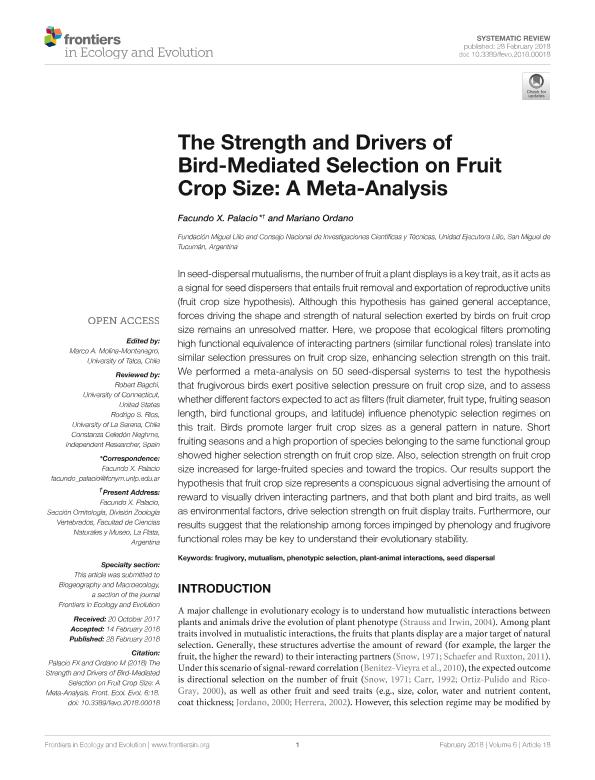Mostrar el registro sencillo del ítem
dc.contributor.author
Palacio, Facundo Xavier

dc.contributor.author
Ordano, Mariano Andrés

dc.date.available
2019-10-17T19:31:54Z
dc.date.issued
2018-02
dc.identifier.citation
Palacio, Facundo Xavier; Ordano, Mariano Andrés; The strength and drivers of bird-mediated selection on fruit crop size: a meta-analysis; Frontiers Research Foundation; Frontiers in Ecology and Evolution; 6; 18; 2-2018; 1-18
dc.identifier.issn
2296-701X
dc.identifier.uri
http://hdl.handle.net/11336/86181
dc.description.abstract
In seed-dispersal mutualisms, the number of fruit a plant displays is a key trait, as it acts asa signal for seed dispersers that entails fruit removal and exportation of reproductive units(fruit crop size hypothesis). Although this hypothesis has gained general acceptance,forces driving the shape and strength of natural selection exerted by birds on fruit cropsize remains an unresolved matter. Here, we propose that ecological filters promotinghigh functional equivalence of interacting partners (similar functional roles) translate intosimilar selection pressures on fruit crop size, enhancing selection strength on this trait.We performed a meta-analysis on 50 seed-dispersal systems to test the hypothesisthat frugivorous birds exert positive selection pressure on fruit crop size, and to assesswhether different factors expected to act as filters (fruit diameter, fruit type, fruiting seasonlength, bird functional groups, and latitude) influence phenotypic selection regimes onthis trait. Birds promote larger fruit crop sizes as a general pattern in nature. Shortfruiting seasons and a high proportion of species belonging to the same functional groupshowed higher selection strength on fruit crop size. Also, selection strength on fruit cropsize increased for large-fruited species and toward the tropics. Our results support thehypothesis that fruit crop size represents a conspicuous signal advertising the amount ofreward to visually driven interacting partners, and that both plant and bird traits, as wellas environmental factors, drive selection strength on fruit display traits. Furthermore, ourresults suggest that the relationship among forces impinged by phenology and frugivorefunctional roles may be key to understand their evolutionary stability.
dc.format
application/pdf
dc.language.iso
eng
dc.publisher
Frontiers Research Foundation

dc.rights
info:eu-repo/semantics/openAccess
dc.rights.uri
https://creativecommons.org/licenses/by-nc-sa/2.5/ar/
dc.subject
FRUGIVORY
dc.subject
MUTUALISM
dc.subject
PHENOTYPIC SELECTION
dc.subject
PLANT-ANIMAL INTERACTIONS
dc.subject
SEED DISPERSAL
dc.subject.classification
Biología

dc.subject.classification
Ciencias Biológicas

dc.subject.classification
CIENCIAS NATURALES Y EXACTAS

dc.title
The strength and drivers of bird-mediated selection on fruit crop size: a meta-analysis
dc.type
info:eu-repo/semantics/article
dc.type
info:ar-repo/semantics/artículo
dc.type
info:eu-repo/semantics/publishedVersion
dc.date.updated
2019-10-16T19:13:25Z
dc.journal.volume
6
dc.journal.number
18
dc.journal.pagination
1-18
dc.journal.pais
Suiza

dc.journal.ciudad
Berna
dc.description.fil
Fil: Palacio, Facundo Xavier. Universidad Nacional de La Plata. Facultad de Ciencias Naturales y Museo. División Zoología de Vertebrados. Sección Ornitología; Argentina. Consejo Nacional de Investigaciones Científicas y Técnicas. Centro Científico Tecnológico - Tucumán. Unidad Ejecutora Lillo; Argentina
dc.description.fil
Fil: Ordano, Mariano Andrés. Fundación Miguel Lillo; Argentina. Consejo Nacional de Investigaciones Científicas y Técnicas. Centro Científico Tecnológico - Tucumán. Unidad Ejecutora Lillo; Argentina
dc.journal.title
Frontiers in Ecology and Evolution
dc.relation.alternativeid
info:eu-repo/semantics/altIdentifier/url/http://journal.frontiersin.org/article/10.3389/fevo.2018.00018/full
dc.relation.alternativeid
info:eu-repo/semantics/altIdentifier/doi/https://doi.org/10.3389/fevo.2018.00018
Archivos asociados
